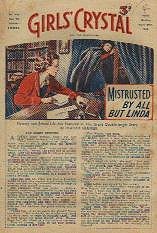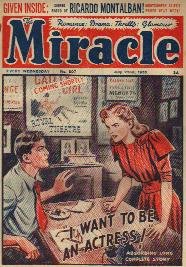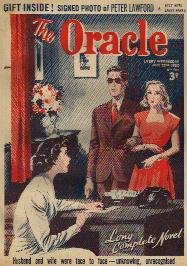| bc | Popular Adolescent
Reading Collection
Article
by Dr Rosemary Montgomery
Dramatic! Enthralling! Why did they disappear? When I chose this title I was thinking of an area of (book) collecting which suffers under a double disadvantage, girls' popular literature between 1935 and 1945. I don't mean collections of Ethel Turner and Louise Mack reprints. Nor do I mean the later Mary Grant Bruce stories or those of Dora Joan Potter. In the 1970's Marcie Muir published her bibliography of Australian children's literature, expressing deep concern over the lack of interest in that subject (1). Since then Australian collectors have specialised in it, and in related areas. We now have some fine public and private collections of case-bound, hard-back literature for children and girls. However there are no really satisfactory collections of the periodicals which were popularly read by girls. As a result of this imbalance modern Australians get a rather distorted view both of what was available and of girls' reading tastes at that time. I realise just how unbalanced the picture currently is when I think of how many periodicals were available then and how widely they were read and enjoyed. I first became aware of this situation when, as part of some research, I asked women across the nation who were the teenagers of the war years, and who could spare the time, to share with me their memories of adolescent reading. The emphasis was on what they liked or disliked enough to recall rather than 'good' reading or proper reading. Their response was astonishing. Many, many women from every state wrote in reply and their separate lists covered everything from Dale Carnegie's How to Win Friends and Influence People to nostalgic re-readings of Pearl Pinkie and Sea Greenie. However, almost all of them mentioned the weekly-paper reading then available to Australian girls in a variety of genres: schoolgirls' papers, English weekly romance papers, short, cheap paper-covered novelettes from Britain, American romance magazines, Australian, British and American movie magazines. I would like to elaborate on the 'double disadvantage' with which I opened this article. The first of the problems is that there are, and have been, so few collecting these publications, the second is that by this time there aren't many papers left for collection. Unfortunately these disadvantages are strengthened by the fact that each of them to some extent has reinforced and currently reinforces the other. Historically there does not seem to have been a great deal of individual interest by the girls themselves in making and keeping a personal collection. Most collectors agree that such a nucleus is a great advantage to the later development of substantial collections. They have been the kernel of some of the fine collections of boys' popular weekly literature, for example. Were there reasons for this failure of a significant number of girls to collect? Were there reasons for the lack of interest in the field subsequently? ONCE THOUGHT TO BE 'RUBBISH' Western rationalism and British-Australian cultural history tend to emphasise the idea that we should DO things rather than FEEL things. As a result stones of any kind in films, books or magazines which were built noticeably around feelings were likely to be dismissed as trash at this time. A good example of this is the commentary in Halliwell's Filmgoer's Companion on 1940's film star, Joan Crawford, 'she has always been 'good box-office' especially with women fans who like to watch her suffering in mink. In another book off my shelves, Ouise Vaupel in Writing the Pulp and Confession told would-be writers in 1944 that the 'theme' of the confession story was emotion 'put emotion against emotion and you have drama.' This accurate definition of True Romance stories was also the death knell of the magazine. Across Australia parents and teachers frowned on girls who read the magazines with story titles implying that life is emotional and sensual. These included the American True Romance and True Confessions, the British Oracle and Miracle; and I am not even thinking about the more explicit versions of this genre which were banned in 1938, but the fairly harmless ones which continued to be imported and continued to be popular. Family expectations also militated against such collections. Dad might have his paper and the boys their comics but, despite the enormous popularity of The Australian Women's Weekly [which incidentally was the favourite magazine of our wartime troops in several surveys (2)], women and girls didn't 'read' in many households. One of my respondents touched on the basis of this situation when she wrote, 'I never knew my mother was a reader until I grew up. She was always so busy.' Later, as Australian collectors moved into the field of girls' literature, the hardback books, prized as gifts, more expensive and therefore more worthy of care, were naturally a lot more easily available from the small individual collections of previous years. Thus we are now lucky enough to have extensive material in this area through the assemblage of the Pound collection and the Lindsay Shaw collection, among others. FEW NOW LEFT FOR
COLLECTION Additionally, girls at home in Australia saw salvage collections as their means of supporting the war effort; and first into the salvage pile went their own weekly reading. The magazines themselves collaborated on this form of destruction. 'Dig out those things you've put by...'exhorted The Oracle, one of the British romance weeklies in 1942. 'Remember rags, rubber, metal and paper are specially important. Don't put it off till tomorrow.' What girl could fall to take the hint. My respondents recall being awarded certificates and medals for the pounds of paper salvage they collected. Salvage in those days, but now the papers that are a pleasure to peruse tell us so much of past life and goals. They fall into clearly defined categories and often the girls progressed from category to category as they grew up. Furthermore, the popularity of the various denominations changed, reflecting Australia's changing circumstances as our allegiances shifted from Britain to America in the dreadful days of 1942. Young teenagers liked The Girls Crystal but many of them were reading the harmless love stories in The Oracle and The Miracle at the same time. These two British story papers, inexpensive at 1d weekly, notable for their duochrome covers and drawn illustrations, were very popular in the first part of the war. Later came the American True Confessions-type magazines with full colour photographs on the cover and photographic illustrations to emphasise the 'real life' stories. They were expensive in Australia at 1 shilling in 1942 when girls like my respondent, Shirley P, were earning thirty five shillings a week. For something melodramatic, but still British and cheap, there were always the 'penny dreadfuls'. By the late 1930's this term had come to be applied to booklets of forty pages with two- or three-coloured covers. Although octavo-sized and containing text only, they lived up to their advertised promise of 'dramatic, enthralling reading with titles like 'Dangerous to Love' and 'A Lonely Heart is Easily Deceived'. At twopence or threepence and containing at least two 'novelettes' they were very probably the natural descendants of the 1900's Keepsake Novels and other penny paperbacks rather than the splendid 'sixpenny wonderfuls' which were already on the way out in the nineteen twenties (3). 'Dangerous to Love' was number 556 of the Girl's Friend Library in November 1936. A Tasmanian respondent wrote of the way in which she and her friends used to buy secondhand copies at school and church fetes and swap them with each other. There must have been thousands of them in Australia once. Where are they now? My respondents recollected reading film magazines too. Some of them preferred the Australian Photoplayer, The Glad Mag of the Movies'. This magazine began in the twenties with a strong Australian flavour but its changing attitudes are clearly reflected in the titles of its articles, its competitions and other inducements to reader involvement as the years passed. 1923 saw its 'Sirens of the Surf competition, with the publication of Australian girls' photographs and a feature article on "Sydney's Finest Theatre'. 1935 trumpeted 'Australia's New Alliance With Great Britain' for major movie releases and offered a double-page spread of 'The Fans' Forum' where readers' views were printed and discussed, as well as quizzes and crosswords. 'Fans' Forum' was still going strong in 1942, as were the crosswords, but the feature articles were more likely now to have titles like 'Sparkling New Shows From Columbia' and Maureen O'Hara becomes an American Citizen'. Other girls with strong British ties enjoyed the British Film Pictorial and Picture Show, slender twenty four-page weeklies with sepia-toned photographs on the cover. Often these came out in parcels from relatives overseas. The 'star' of all movie magazines was unquestionably Photoplay with its full-colour, hand-tinted cover portraits of the major film actors. Twice as big as Australia's similarly named film paper, with more than twice the pages and at more than twice the price, by 1939 it was possible for the original purchaser to sell it again to swap shops or small circulating libraries. However, American publishers catered to all types of movie goers and their purses. Less expensive at 6d in 1939 from the NSW Bookstall Company was Screen Romance, which, as the title indicates, tried for a foot in both the movie mag and true confessions camps. Movie Story ran pages of text under the banner 'Read your movies and then see them', while the cheaper, mini-luxury of Photoplay 'wannabe', Screenland included lavish illustrations and pinups of both sexes, all downsized and in sepia tones. Every one of the categories was popular - and the magazines in each of them have suffered the natural consequences of this. With very few exceptions they have fallen prey to the natural results of enthusiastic swapping and frequent reading. In addition, even more enthusiastic salvage collection and, of course, the passage of time has meant the further decimation of their numbers. I began this article by saying that in the seventies the idea of girls' hardback literature began to capture the interest and imagination of collectors. As a result, the collections in that field are solidly grounded; public value and private pleasure are well served. Without setting aside that interest, perhaps the time has come for another focus, to ensure that we don't lose some or all of the literature in the categories I am writing about here. Fragile, ignored, deteriorating under unsuitable conditions; time is rapidly running out for the few remaining examples of the millions of copies of weekly papers and magazines read by Australian adolescent girls in the thirties and forties. This means time is running out for us as collectors too. Ten years ago a bundle of about a hundred wartime Miracles and Oracles was found on a council tip in Victoria, salvaged in relatively good order and ultimately passed on to me. What was it like when I opened the box and saw these rarities? Dramatic! Enthralling! But there must be fewer and fewer finds like that. If we don't do something about collecting and maintaining the reading ephemera of these years those that now remain will soon have disappeared irrevocably and the nation will be poorer both in a general and a particular way. The war has been over for fifty years and soon we will not have even the memory of the existence of this kind of material or the extent of its popularity. Our view of what Australian people read and how it influenced them at a certain time will be distorted, and ultimately false Let's start searching, discussing, persuading and, finally, putting together collections of girls' popular reading to create yet another interesting piece in the Jigsaw of Australia's past. I'd be interested in hearing from anyone with any thoughts on this collection area. My email address is: nlmont@ozemail.com.au End Notes: (1) Marcie Muir, 'Introduction', Australian
Children's Books: A Bibliography, Vol I. I774-I972,
Melbourne, MUP, I992,p xi. Site editor's note: The authors or publications highlighted in red are, or will be, covered elsewhere on the CB&M site. The scans, which illustrate the cover illustrations not the entire cover at the top of the page are from my collection. Dates are as follows: GC #445 dated April 29, 1944; Miracle #807 dated July 22, 1950 and Oracle #911 dated July 22, 1950. Many copies of the latter two publications are available. |
bc |


